

Myself (Greg Egan), Dick Hargrave & Ray Cooper at Bairnsdale
Airshow with Duigan, P15035 and the Cat
Photo: J. Bird
"Flying: the brief period between repairs" - © G.K. Egan 2001.
These pages are a running record of my flying activities updated spasmodically.
Very early on (1960's) at the Mildura Technical School sports ovals I flew IC powered control-line balsa planks models carrying house bricks - to see whether it could be done of course! Actually they were half bricks as that was all our puny teenage arms could cope with pulling on the lines.
From memory I started flying again around September 2001.
Check out You Tube for flight videos (gke3800).
In reverse build order.
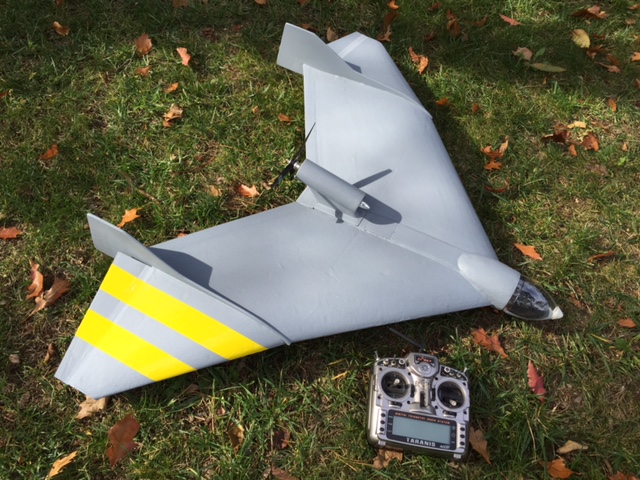
Ready for Test Flight(s) 23 May 2016
20160524
Maiden @ VARMS
20160531 Low & Slow
@ VARMS
20160602 EDF V1 @
VARMS
Based on Josef Poisinger's Build. In my case a 1200mm version and foam cored with 8% section. There is an RCGroups Blog.
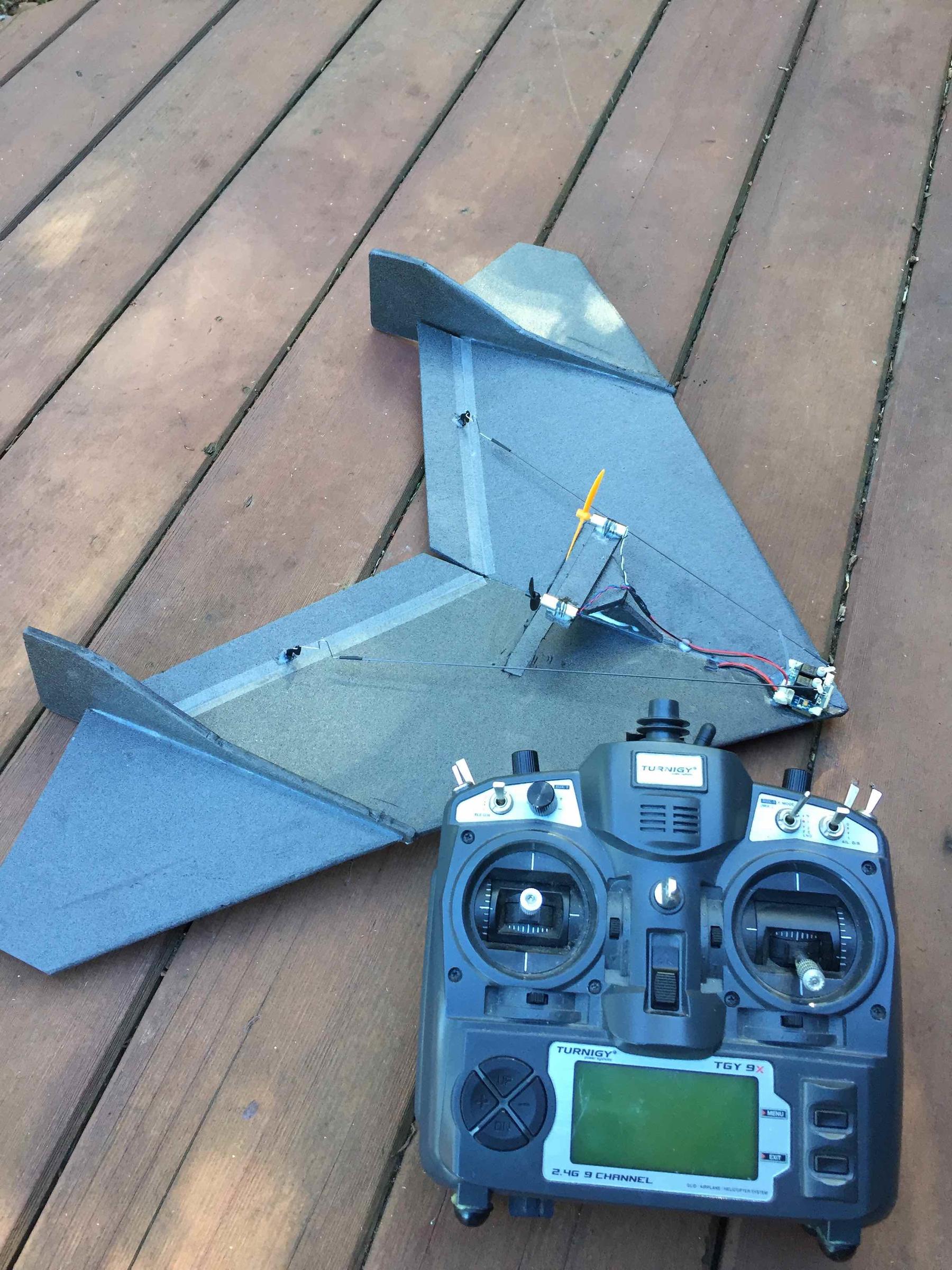
600mm Indoor Version March 2016
I built a quicky 600mm indoor version using WLToys Polecat electronics and Diaso ColorBoard foam. There is an RCGroups Blog of the build details.
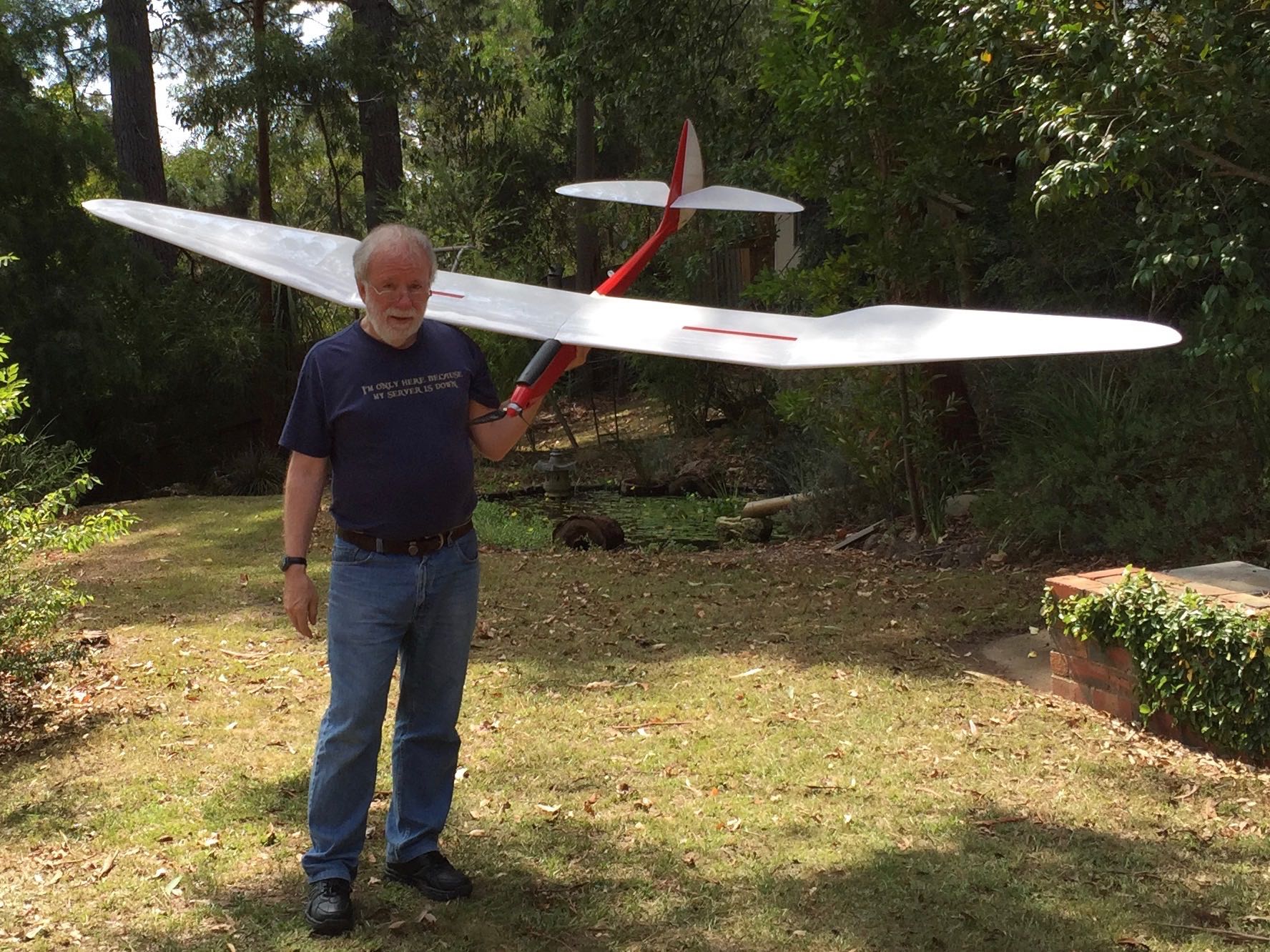
Ready to Fly March 2016.
Fuselage built by Birdy and Roger. Birdy was unhappy with kit balsa but I elected to follow through with original kit adding air brakes and 8x0.5mm carbon straps to the bottom spar and replaced inboard ply shear web plates with 2mm carbon sheet at the wing roots. AUW 1.9Kg.
Maidened 22 March 2016 @ VARMS - thanks Ray. Magnificent!
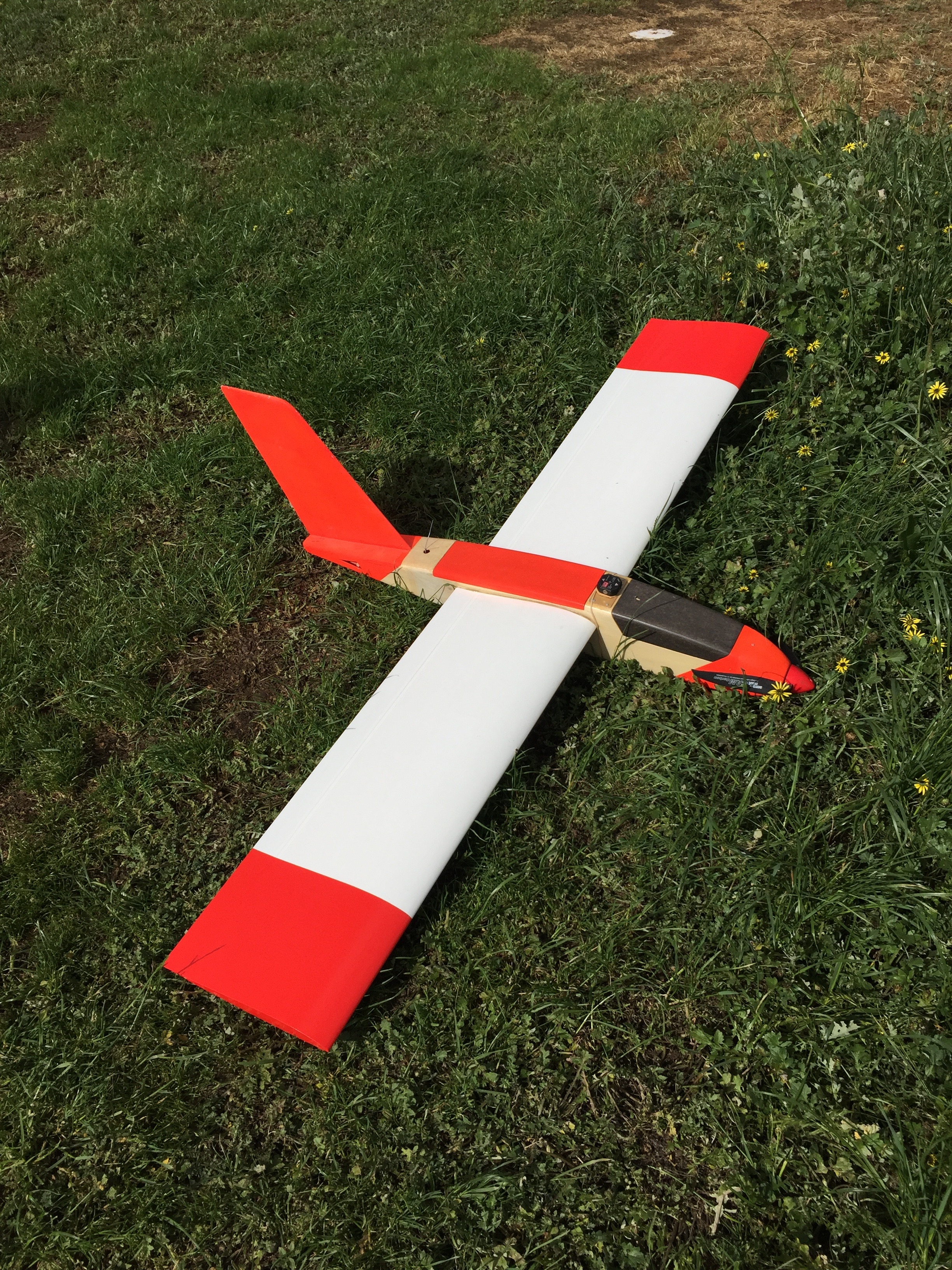
Muesli October 2014
Medium aspect ratio (1.8M, 250mm) plank looking surprisingly like the P16025 and constructed by Ray Cooper. Not a recent build - more like removing some decals from an old bird.
While Muesli uses the EMX07 airfoil in the future I may try the PW75 which has less drag than the EMX07, an adequate Cl and the same positive pitching moment. The PW75 seems similar to the JWL065 but a little more consistent over a range of REs.
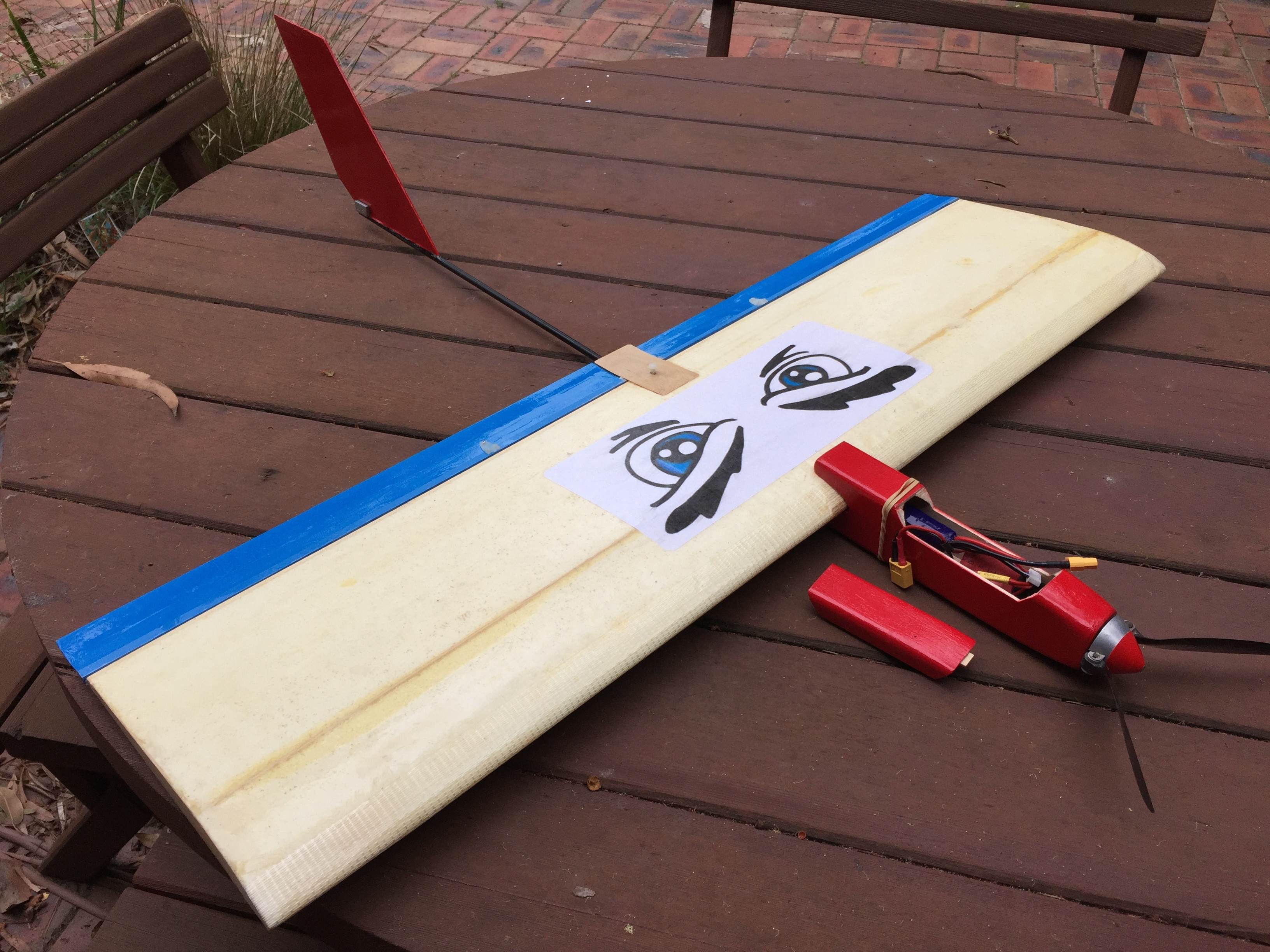
PopCorn January 2016
Successor to Cornflake. Rebuilt fuselage after a radio outage at Kilcunda - antenna pointing at aircraft! There are some VERY rough build notes (zip) after requests from VARMS members.
Only damage so far was a badly split fuselage after being blown head over heels backwards down the field after landing in wind velocities higher than PopCorn's flying speed. Some white glue and fixed!
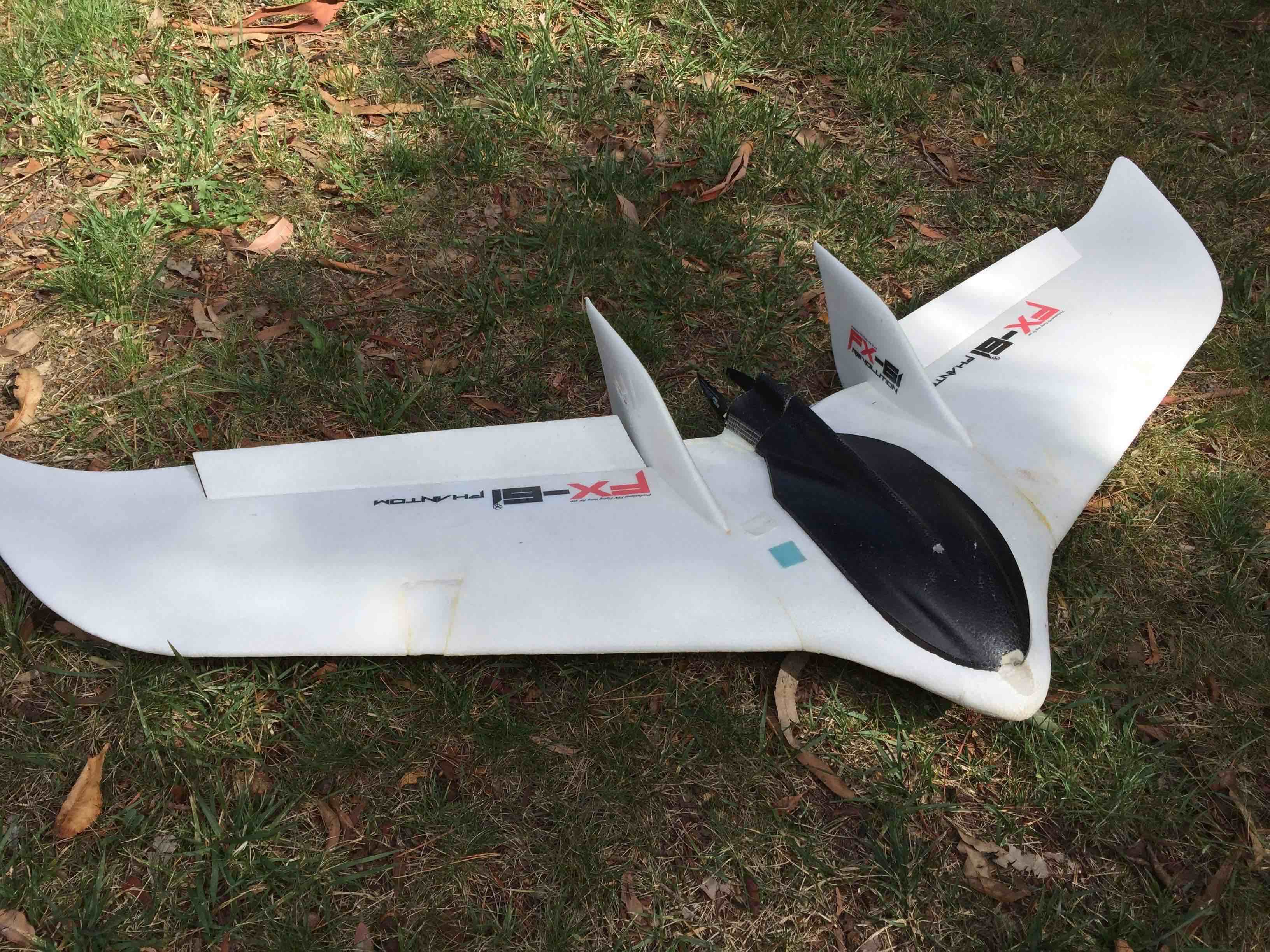
Phantom with Colin Smith "Kilcunda Notch" (Right Wing) February 2016
Changed motor to Turnigy D3536/6 with 9x6 Aeronaut Folder. Added Birdy preventers (fibre glass plates in hub crossbar) to stop prop crossover when trailing and flicking forward hitting the wing at spinup.
OK on the slopes. Fins are largely decorative as it flies about the same without them. The usual yaw squirms common in some wings!

Fluity @ Home 21 January 20142014
"Fluity" is corflute flying wing design due to Paul Van Tongeren aka Bixler Boy. Build time was about four hours including waiting for paint to dry.
All up weight 550gm. Drive line is a mild ex AXN Cloud Floater
with 7x5 prop and 1000mAH 3S pack. Not a white knuckle rocket but does vertical
happily and covers the sky quickly enough. On the numbers should do a little
over 100KmPH but the airfoil section is WYSIWYG so when drag meets thrust is
anyone's guess. Throws +/-8mm aileron and +/-6mm elevator.
Had a minor oops when when demonstrating at Pauls workshop accidentally launching
with maximum rates - several snap rolls right and several snap rolls left at
an altitude of about 1-2M then a "controlled impact with terrain"
as NASA would say at high speed. Damage was extensive LOL - broken prop or more
correctly blades removed and a slightly bent motor mount. Back in the air next
day.
Discus launches seem to work and are necessary on still days with about 5% up
dialed in. I don't recommend hand launches for pushers BTW - just my choice
but but when I do it I do it with my thumb across the throttle holding it off.
I now have my Taranis which is programmed to "yell" at me if I don't
have low rates selected at least for launch .
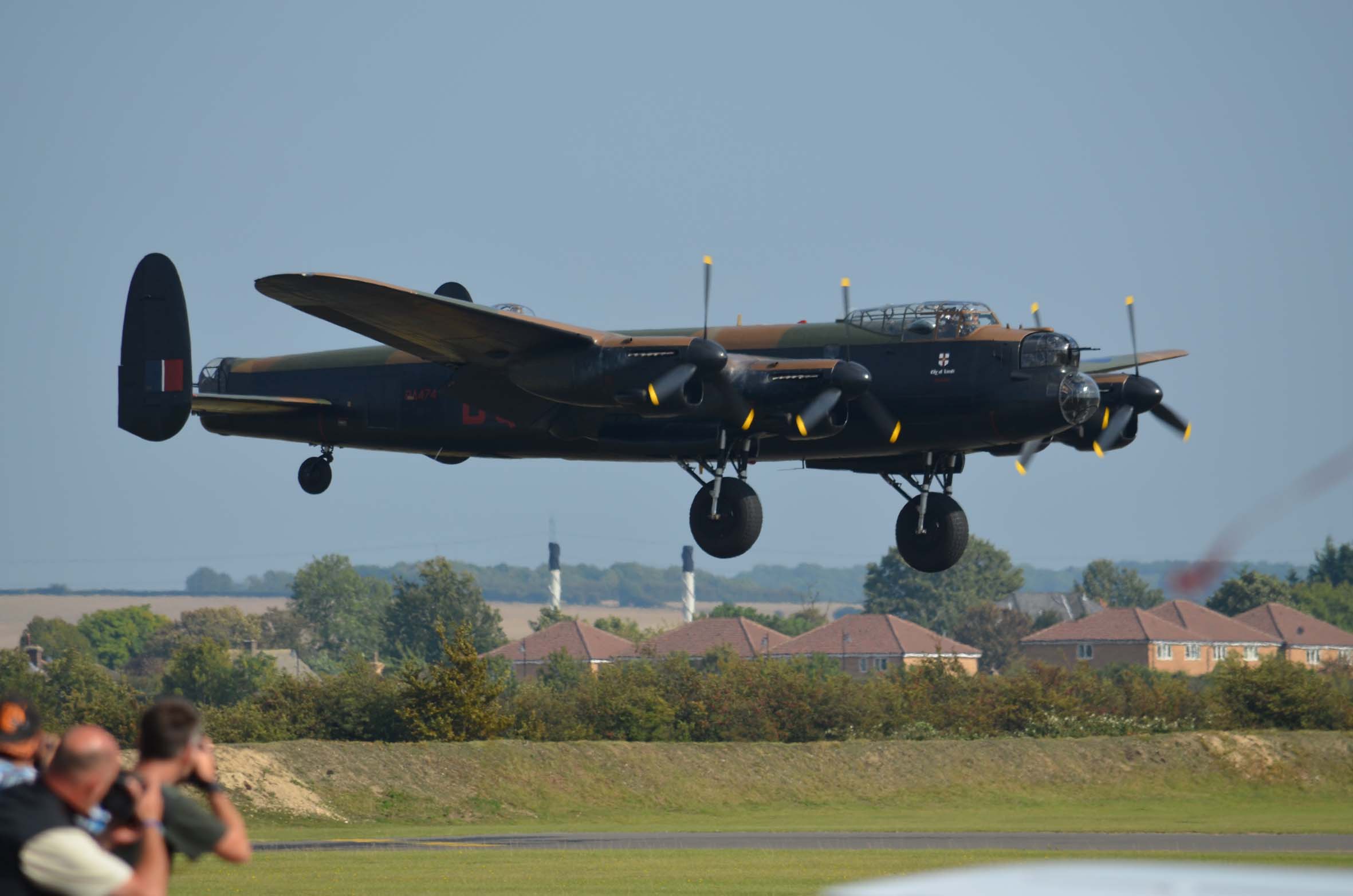
The Real Deal @ Spitfire 75th Duxford IWM September 2011 - Copyright © G.K. Egan

Lancaster "Aries" November 2015 - Copyright © G.K. Egan
There was no excuse for buying this in 2006! The Lancaster kit was designed by Tony Nijhuis but has a 72" span not Tony's scaled up larger 17' version. Others have had fun building it including a few mixups with the plans.
SLEC produces a part kit with CNC cut formers and ribs.The CNC ribs I received at the time were VERY warped like the Spitfire kit. This was going to mean a lot of fiddling to get things lined up in an acceptable manner.
Recommenced building in 2011. Kit was reasonably complicated and I thought at the time probably more so to fly.
I changed the build sequence a little as I found the nominal sequence to be messy. The fuselage tops do not curve easily even when damped with water and ammonia. I would use planking next time. I have built the centre wing panels as one piece and will cut them apart later. Some templates on the plans for the rib angling for motors would have been useful as it is easy to get it wrong.
Late decision to initially finish as a Manchester to be flown bare balsa which I did 21 October 2013. It is a pussy cat to fly. Hopefully it will not take another seven years to paint.
Finally completed in 2015 as the Lancaster Aries after some sagas with the undercarriage. Still needs decent flair when landing but that's probably as it should be! 4x Turnigy 2213/20 with three blade 8x6 Master Airscrew counter rotating props. 4900mAH 3s pack. 3Kg AUW.
There is a construction page.
Rescued from a kerbside rubbish collection in our street. It turned out that the aircraft was a very rare Japanese OK Model Co. Ltd. Pilot Hit Kit Series Attacker 2. It was probably 30 or so years old and had never been flown. I made the minimum modifications to convert it to electric (bulkhead 1) before realising what it was, otherwise it was in in the original state as rescued when flown.
Bought in 2010 this was the baby Freewing version with the 64mm fan and no undercarriage. Added two servos for elevators and the suggested duct deflector to prevent pitch down at launch. The latter was not needed, as it turns out, being spat out in flight with extreme vectored thrust and some excitement while being flown by Damien Mould. Launch slightly upwards at around 50% throttle with a little up mixed in perhaps. Flys suprisingly well according to the jet experts. Interesting to launch but easy to fly in good light and blue skies as it is grey coloured and VERY small and so not compatible with early morning fog and overcast. Happily cruises around at 35% throttle with vertical available using a 2000mAH 3S pack.
Fuselage eventually gave up in 2014 so in a moment of madness replaced with HK even smaller version which I may never build up as it is just to silly.
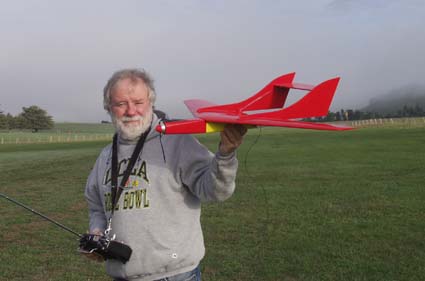
Further Modifications (Shorter Nose) @ Yarra Glen 10 June 2009
Only a faint resemblance to the original Pushy Cat. Busby likes to go FAST and as rebuilt is great on the slope and, now it has something to hang onto, flat-field as well. Spoilerons work well to tame quick landings although it lands fine without. Have not tried an elevon configuration - yet.
There is a construction page.
RC Groups Thread (all variants).
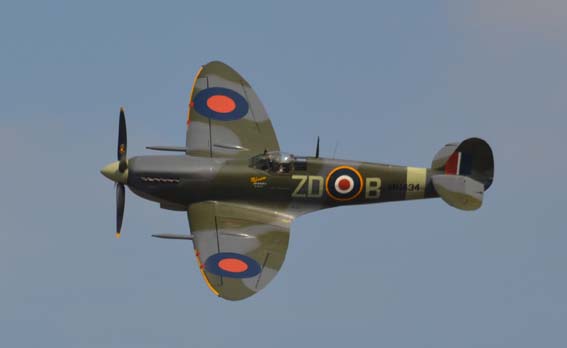
The Real Deal @ Spitfire 75th Duxford IWM September 2011 - Copyright © G.K. Egan
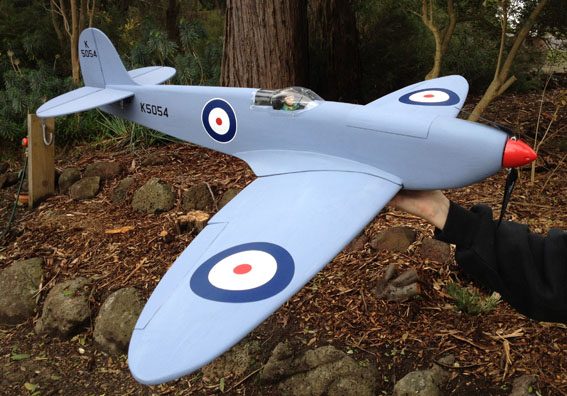
Spitfire in K5054 Colours - 23 June 2012 - Finished at Last!
Every boy has to build a Spitfire! The kit is a full ground up design by Tony Nijhuis published late 2006 by RCM&E. SLEC produces a part kit with CNC cut fuselage panels, formers and ribs. The ply ribs warped badly when broken out of the sheets. Unfortunately it was after I glued them in that someone suggested steaming them and then putting them under weights! Good idea Batman. There are construction photos, some while in Manchester without my workshop.
I will complete the scratch built aircraft as I just cannot miss the "joy" of construction and inhaling a tree or two of balsa, despite mask, in the extensive sanding process.
CG very difficult with 2x2000 3S packs plus 150gm of lead with predicted best airspeed 11MPS! First flight 7 January 2012 - result star picket 1, Spitfire nil. Stalled on landing approach - way too slow. Flies OK on the slope in a strong breeze.
Construction/reconstruction photos.

Hobby King Spitfire @ Yarra Glen circa November 2008
On 7 April 2008 I ordered a ARF HK Spitfire from Col Taylor in Oz for $89 on sale. A great deal compared with the similar cost for a box of balsa and some CNC bits and the rest to be purchased. Unfortunately the last one in stock set aside for me came to a tragic end, reportedly involving a foot, just before being shipped. I ordered a HK Spitfire from Hobby City 30 May 2008 instead. 100 odd aircraft in the shipment sold in a couple of days with no more to be available - reportedly. Mine delivered 13 June 2008. Construction commenced 20 October 2008. There are some build notes and a RC Groups Thread.
It is excellent on the slopes and will thermal!
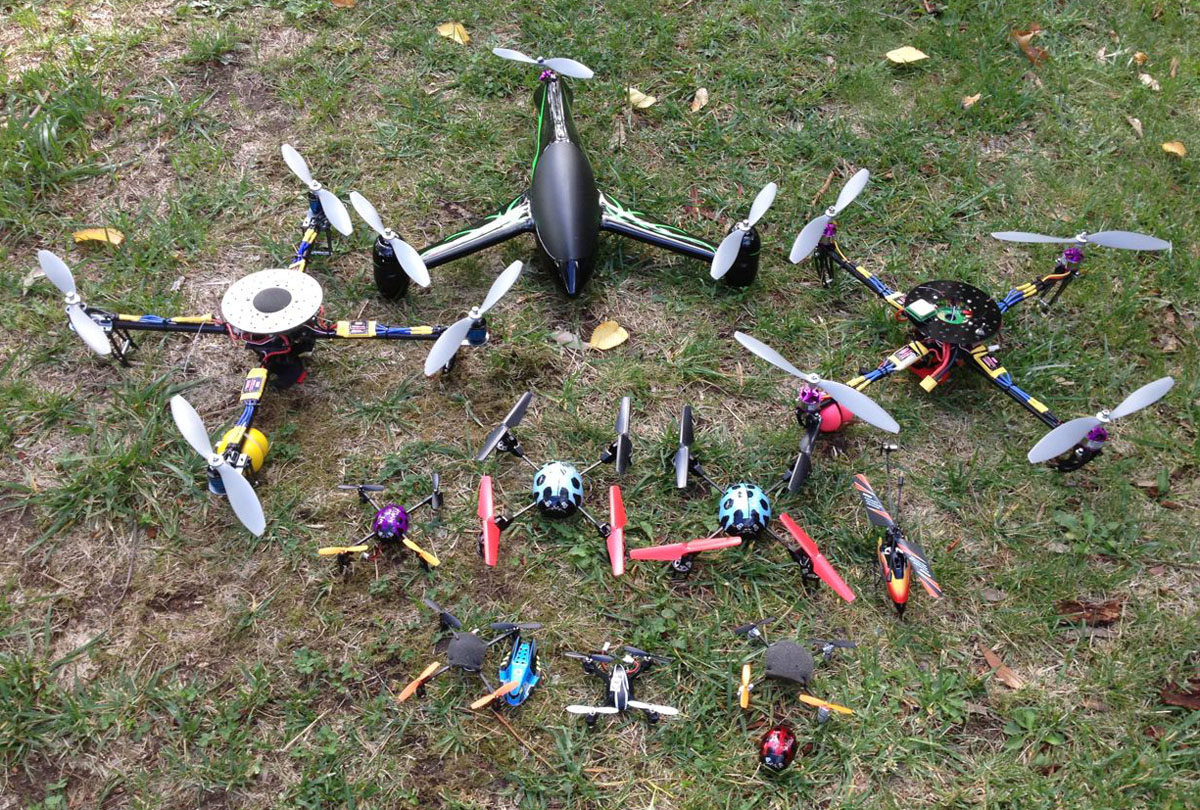
The Multicopter Collection (incomplete - I have many many more!)
@ Home 25 April 2013
"You can't have too many multicopters" (C) J. Solinski
There is a gitHub where the quadrocopter/tricopter programs I have developed/rewritten so far may be found.
RCGroups Blog | gitHub | UAVX Thread | Warthox's flight collection.
Starting in 2008 this was a little different and a reasonable alternative to trying to have more conventional aircraft work as a VTOL solution although I have the ducted fans for that as well. I am using the standard INS based quadrocopter processor board initially but then may use my autopilot.
Some initial programming issues the control software has been loaded succesfully to PIC processor and tested after some time in determinig that the "lipoly.de" preloaded PIC did not have a bootloader installed and was the wrong configuraton - my fault. Fortunately I have the kit to program blank PICs.
Construction of my first quadrocopter commenced in earnest 10 June 2008 and finished pretty much the same day with all static motor tests done. Motors are 4 Hyperion Z2213-24 outrunners with Titan 20A ESCs and the normal 10x4.7 props; Quadrocopter Black Board (initially V3.15b5 firmware). Motors are at a 600mm pitch to suit the lead lengths; I had planned 800mm! Motocalc predicted performance with one Hyperion 2000mAH LZ pack is 2513gm thrust 918gm mass, 3:14 minutes and seconds @ 100% and 14:27 @ 55% hover. For 2x2000mAH, 2685gm thrust, 1077gm mass, 6:04 @ 100%, 24:03 @ 58%. Should comfortably take my Pentax Optio S with pan tilt servos.
First flights in my lounge room 11 June 2008 at 200mm off the carpet - interesting. Trims work OK, Pitch Gain was inverted so first flight resulted in a backflip. Failed to watch for the VERY bright LED alarm as the LiPoly went down to 7.8V while I was enjoying myself. Proportional control OK but there are issues with PID integrators.
On 14 June 2008 I rigged up a tuning frame pinning the frame on either the pitch or roll axis. I suspect there may be a leak in the integrator adding to the fun. I will order ADXRS300 gyros which hopefully will be compatible with the ADXRS150 on the yaw axis. Flights June 16, 2008 good fun but the daffodils on the lawn suffered. The idle was set deliberately low at 5% so flights could be terminated quickly to avoid the surrounding shrubbery and, of course, the video camera.
Short movie [.mov 1.1Mb] 16 June 2008 nothing broken by the way, just a decisive landing to avoid the camera.
Whilst OS on holidays June-July 2008 I wrote a Zeigler Nichols tuning spreadsheet as a possible contribution to the Quadrocopter community. There seemed to be no consistent way of obtaining the PID tuning parameters other than "suck it and see". I also partially rewrote the Wolfgang Mahringer's UAVP 3.14 control code for the Microchip C18 compiler and the 18F2520 pin compatible update of the 16F876 as this was the easiest way for me at least understand what the code actually did. The Next Generation quadrocopter effort has of course jumped to ARM but there quite a few of us with legacy UAVP kit.
I completely rewrote UAVP, renamed UAVX, with GPS based navigation based on the 18F2620 PIC with no other hardware mods required on the original UAVP "black" board. UAVX was release 15 August 2009 Australian EST. Thanks go to Jim Solinski (Jesolins) for much of the ongoing UAVX flight testing.
There are also some short notes and associated video on my ZN tuning experiments - DON'T TRY THIS AT HOME "CHILDREN".
2012 and the saga continues or is that the coding Albatross still lives? New UAVXArm32F4 version now flying using Ken Yu's board. Steve Westerfeld assisted with much of the testing and engineering of the mbed version which immediately preceded UAVXArm.
2015 and I have lost count of how many multicopters I have so far, many of which use my UAVX and MWLite software so the OCD is under control or perhaps not! Much of the software I wrote is off the links above. I now mainly use Ecks framed quadrocopters for outside.
The Open HUB People put the time so far developing UAVP/UAVX as 76 years at a monetary value of $4.1M! Time to stop - maybe.
More retail therapy acquired February 19, 2008 - becoming a habit. There is most likely a good reason why my kit was so cheap as it may be a KNOCKOFF/CLONE/COPY. Before choosing a supplier READ THIS and THIS and make up your own mind. My kit had no instruction manual and the box had no cover label - clear alarm bells in hindsight. The kit I purchased certainly has deficiencies in quality.

John Bird's Eagle and my Cockatoo (before paint jobs) @ Yarra Glen 8 March 2008
There are construction notes and photos including bolt on wings rather than rubber bands. General EPP Eagle information from the original designer. Also the extensive RC Groups Eagle Thread.
I initially christened it a Galah (read the first paragraph) but could not stand the idea of a pink aircraft so it is Cockatoo. A good fun flyer thermalling easily but do buy the original.
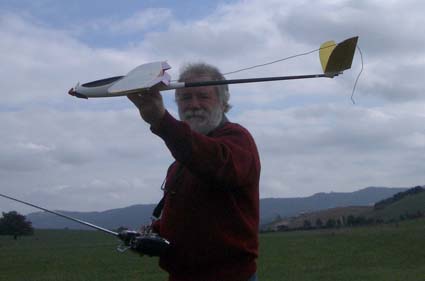
Modified Canary - Flaps and Spoilerons Deployed Yarra Glen May 12, 2008
A little spontaneous retail therapy, delivered 1 February 2008 and first flown 10 February, and now something to have in the car boot. I chose yellow as John Bird chose magenta - we don't want to go flying each others aircraft as we have done before.
There are some build notes and photos. Further improvements were made by 5 May 2008 including moving the spoileron servos outboard and adding flaps; all up weight 504gm. See also RC Groups Thread.
Why "Canary"? Because its a tiny yellow bird of course.

Microjet @ Yarra Glen May 12, 2008
Spontaneous purchase to test my autopilot against Paparazzi Group's claims. I made the fins demountable by inserting rawl plugs in their bases and tapping them for 3mm nylon bolts.
The aircraft is VERY difficult to hand launch except on a slope site with
a bit of air underneath. Once in the air it is surprisingly easy to fly
if you pay attention to getting the CG just right, which you tend to do
if you spend a lot of time flying planks and flying wings. Up trim of 3mm
left and about 5mm on the right to counter torque and add reflex helps a
bit. Most wings and planks need extra up trim on launch because very little
pitching moment is generated until the aircraft is actually flying. Microjet
stalls at about 12M/S and flies at about 15M/S - how good is your arm?
The standard power-train of a 6V Permax S400 and Gunther prop on 7x500AR
cells is hopeless! I used a 6V Graupner with 6x3 folder and 3s 1700mAH LiPo
which, while still conservative, gives good ROC and a reasonable endurance
at the same all up weight without resorting to brushless motors. For folders
in pusher configuration rotate the blades and use a rectangular shim overlapping
the blade root under the spinner nut to prevent blade cross-over; this idea
is due to Professor J. Bird.
The configuration 20 April 2008 uses a Mega 16/15/2 (spare to hand from
a planned ducted fan VTOL) and a 4.1x4.1 fixed propellor with a 2000mAH
LiPo. Performance should be adequate if I can get it in the sky! Hint: do
not use long bungees for lauching MicroJets; catapults good, bungees very
bad. I should, of course, know this! Everything is fixable but too much
boiling water to uncompact EPP can lead to lizard skin.
Returning to brushed S400 for some practice. A couple of succesful flights
6 May 2008 at Yarra
Glen. Co-Pilot not useful - too sluggish in updates - removed for next
fights. Launch aided and flights made interesting by turbulent 7M/S Northerly.
Several flights 9 May 2008 with Gunther propellor at around 14A and zero
wind. The 6x3 tried way back (above) draws too high a current (18A+) with
newer LiPos and their higher terminal voltage under load. One soft landing
in fresh brown stuff (its a farm) necessitating a wash
(pretty much clean by then) under a tap. WeldBond glue joining bits
together started to melt in damp conditions so I have painted over the glue
with SpeedClear™. Used 580 of the 800mAH pack over half a dozen flights;
motor and pack cold on landing.
Very pleased I can actually launch, fly and land this thing - now Norwegian Blue as there was more glue than foam.
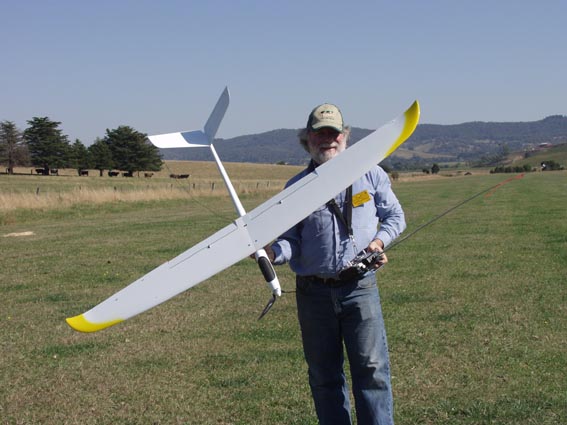
First Flights Mini Graphite at Yarra Glen 22 April 2005
Photo: J. Bird
The Mini Graphite was acquired, after a very long shipping delay (several months), at Ray Cooper's prompting that I needed to get a "real aircraft" as distinct from the planks. Having completed the construction I first flew with an AXI2820/10 and 10x6 folder. This was replaced by a Hyperion 3019/12 with a 12x8 folder now an 11x7 (2016). The batteries are 3s Lipos.
Only damage so far is a slight chip out of the rudder, caused by insufficient control authority and a barbed-wire fence at Kilcunda, and some gel coat cracks in the tail boom where I dropped in vertically in the Hollowback Saddle after going to far down wind and a motor that did not start (dead ESC phase).
The Mini Graphite is an absolute joy to fly on either slope or flat field now I have (at last) mastered the flaps, crow braking, camber control, differential settings etc etc. More practice is required.

Weetie Yarra Glen 20 February 2006
Photo: J. Bird
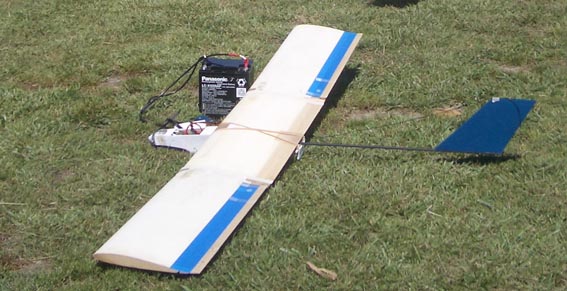
Weetie with wing extensions @ Yarra Glen 15 December 2004


29 October 2009 @ Fitzgerald River WA
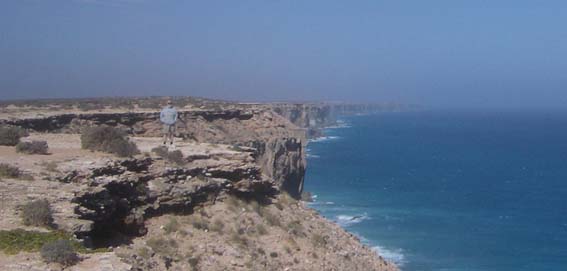
Cornflakes "BIG Day Out" 22 October 2009 @ Bunda Cliffs SA (Google Earth)
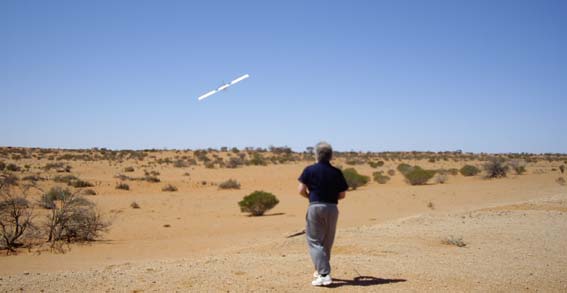
17 October 2009 @ Carots' Bore - William Creek to Coober Pedy Road SA
Photos above taken on a little road trip of 7070Km from Melbourne to Perth on one of Australia's scenic routes.
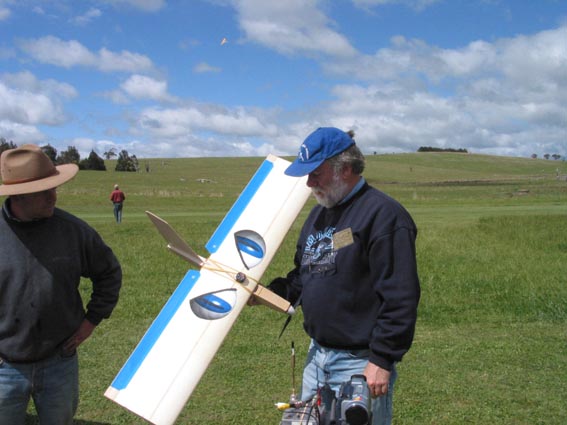
Cornflake Mk I Short Tail 13 October 2002 @ Yarra
Glen
Photo: J. Bird
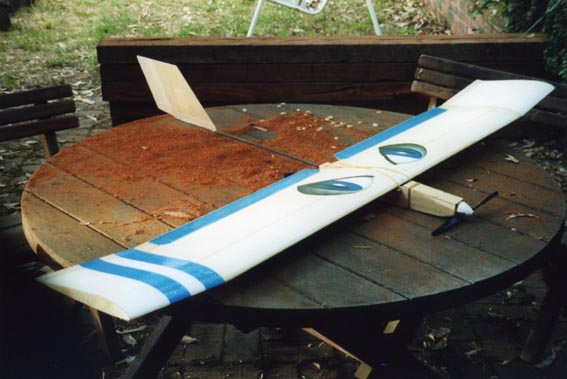
Cornflake with wing extensions @ Home (sawdust is not from aircraft!)
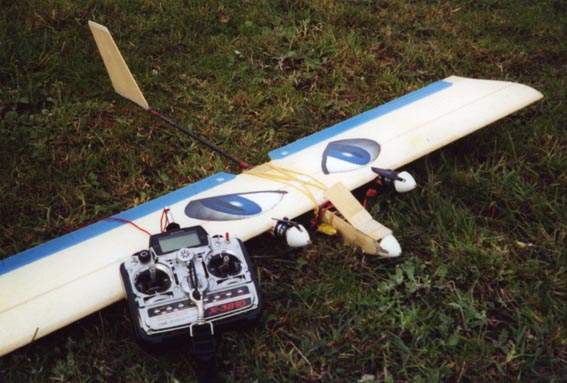
Twin Engined Cornflake
At the prompting of Ray Cooper I tried twin S400s with 6x3 folders. The engines had to be on extended booms for CG and also so the folders opened up when the motors were restarted in flight - a small consideration. It worked quite well and sounded great but had slightly lower rate of climb than the geared 11x8 version and less than half the endurance. I thought that adding two geared 11x8 motors may be a little excessive.
On April 7, 2008 I replaced the geared S400 with a Hyperion HP-Z2213-24 outrunner followed by a cheap Himark C2812/26, 10x6 propellor, and a 2000mAH 3s LiPoly. I would have preferred an 800mAH but the CG prohibited it. Very agile and still nice to fly after all these years and an hour and a half in the air at cruise.
Primera with 2x6 Wing and original fuselage
Photo: J. Bird
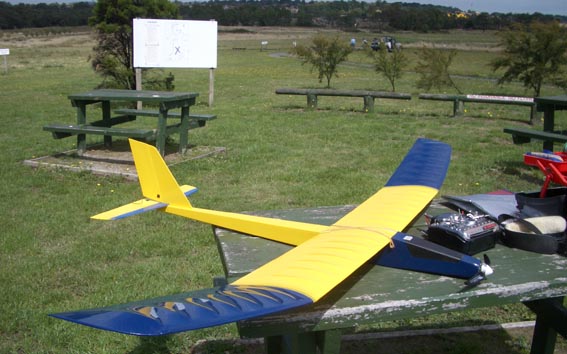
Phoenix with new fuselage at Brigg's Field (VARMS)
Photo: G.K. Egan
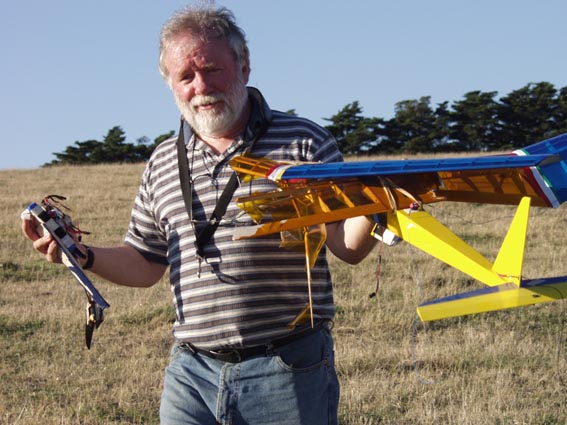
Phoenix 25 March 2006 - flying again 29 March 2006
superficial damage only!
Photo: J. Bird
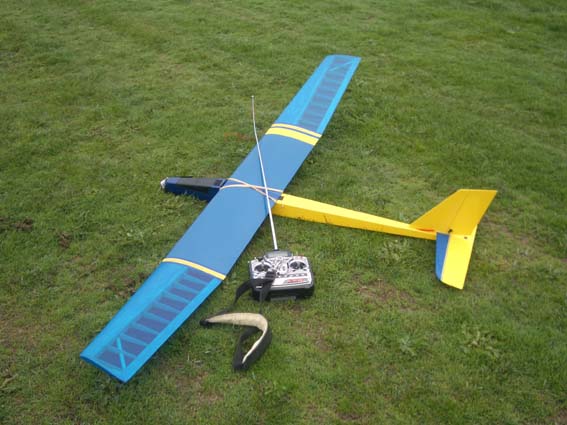
Phoenix with my Prelude wing

2X6 Wing Spoilers with direct deployment by servo arm and retraction by magnet
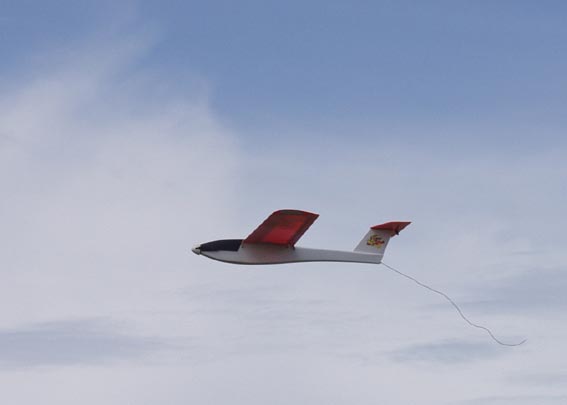
Coyote Yarra Glen 3 February 2006
Photo: J. Bird
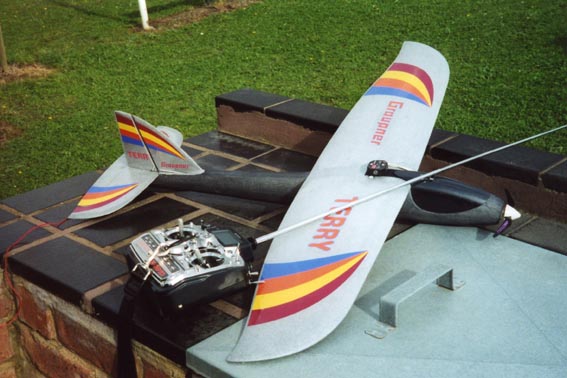
Graupner Terry V2 with black stocking sleeve at Briggs Field Post Major Crash
Bought for slope soaring. Loss of radio control on one flight resulted in a pile of foam (not EPP). The pieces were glued back together with PVA and inserted into a length of stocking also painted with PVA; a dose of boiling water helped partially restore the shape of the fragments. This repair method, suggested by John Bird, worked fine. The wing which has no spar, relying only on the stick on logo, had a distinct tendency to fold in two and the aircraft was finally converted to a slope glider by removing the S400 and battery. As a slope soarer it tends to annoy others as it is extremely light and with the RG15 wing slippery and so thermals easily.
Resucitated 7 November 2008 with the Cockatoo's servos and powertrain. Still great fun to fly and has now been fitted with a carbon spar. Graupner has re-released in white EPP (RCM&E October 2008).
Autopilot First Flight Kilcunda Ridge 16 October 2003
Photo: J. Bird
Last flown with a Turnigy 2213/20 brushless and 9x6 Prop.
I made the winglets demountable by inserting rawl plugs in the wing-tips and tapping them for nylon bolts. The winglets are made of coreflute and the wing halves are joined using a carbon fibre rod inserted into arrow shaft spars. The original motor tray was abandoned and a fuselage box made which could be inserted at will between the wing halves in either a glider or powered configuration. The whole aircraft packs down into the original Zagi box. Many of the construction techniques were due to the ideas of John Bird.
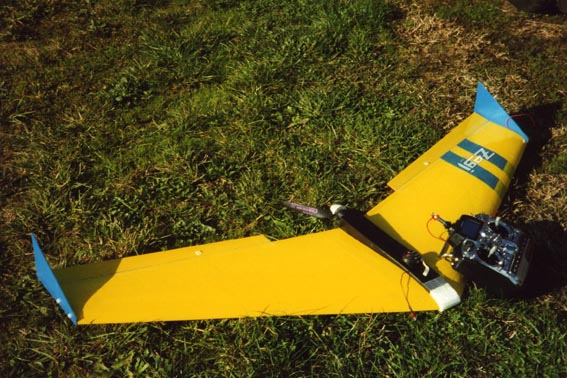
Much redesigned Zagi 400 with removable power pod and S400 4:1 geared 11x8
![]()
Powered (with Autopilot) and Glider Configurations Kilcunda Ridge 16 October
2003
It was VERY windy hence the foot
Photo: J. Bird
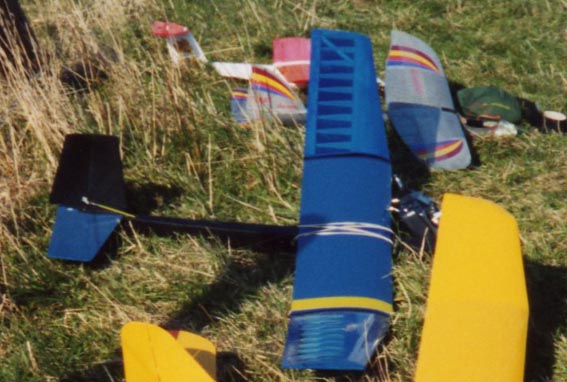
Prelude (Black and Blue) and Friends at Kilcunda Ridge

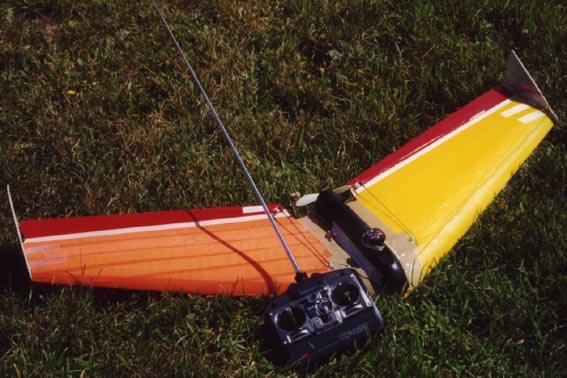
John Bird's Zagi on loan and fitted with a Zagi 400 motor setup and FMA Co-Pilot
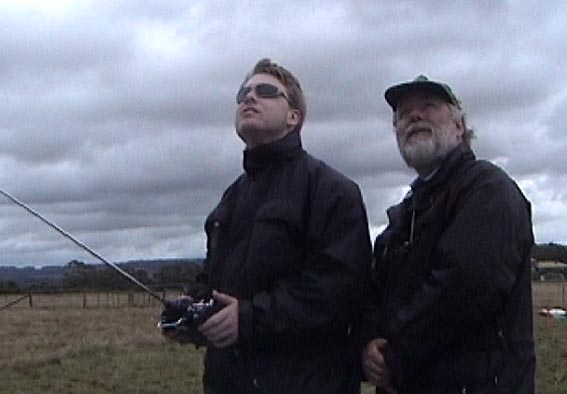
My son Sean and I flying the electrified Zagi at Kirwan's Port Welshpool
7 March 2002
Sean found it too easy
Photo: J. Bird

VARMS, AMSA Indoor Aviation & YVA home fields.
Most slope sites including Kilcunda& Glenfern Road
Woomera
Bunya Cliffs
etc etcTorquay Dunes - alas no more
Ray CooperJohn Bird (in spirit)Roger GibbsThe members of AMSA Indoor Aviation , VARMS and YVA
Jim Solinski (Jesolins - San Antonio), Ken Yu (Los Angeles) & numerous UAVP/UAVX folk.
Terry Cornall - but not for a while!
Copyright © G.K. & S.P. Egan - All rights reserved. Last updated March, 2016.